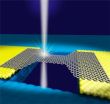(Press-News.org) Graphene, a material that consists of a lattice of carbon atoms, one atom thick, is widely touted as being the most electrically conductive material ever studied. However, not all graphene is the same. With so few atoms comprising the entirety of the material, the arrangement of each one has an impact on its overall function.
Now, for the first time, researchers from the University of Pennsylvania have used a cutting-edge microscope to study the relationship between the atomic geometry of a ribbon of graphene and its electrical properties.
A deeper understanding of this relationship will be necessary for the design of graphene-based integrated circuits, computer chips and other electronic devices.
The study was led by professors A.T. Charlie Johnson and Marija Drndić, both of the Department of Physics and Astronomy in Penn's School of Arts & Sciences, along with Zhengqing John Qi, a member of Johnson's lab, and Julio Rodríguez-Manzo from Drndic's lab. Sung Ju Hong, then a member of Johnson's lab, also contributed to the study.
The Penn team collaborated with researchers at Brookhaven National Laboratory, the Université Catholique de Louvain in Belgium and Seoul National University in South Korea.
Their study was published in the journal Nano Letters.
The team's experiments were enabled by Brookhaven's aberration-corrected transmission electron microscope, or AC-TEM. By focusing the microscope's electron beam, the researchers were able to controllably cut sheets of graphene into ribbons with widths as small as 10 nanometers, while keeping them connected to an electricity source outside the microscope. They then could use the AC-TEM's nanoscopic resolution to distinguish between individual carbon atoms within those ribbons. This level of precision was necessary to determine how the carbon atoms on the edges of the nanoribbons were oriented.
"We're relating the structure of the graphene — its atomic arrangement — to its electrical transport properties," said Drndić. "In particular, we were looking at the edges, which we were able to identify the geometry of."
"Graphene looks like chicken wire, and you can cut up this hexagonal lattice of carbon atoms in different ways, producing different shapes on the edge," she said. "But if you cut it one way, it might behave more like a metal, and, if you cut it another way, it could be more like a semiconductor."
For any piece of graphene, either the pointy or flat sides of its carbon hexagons might be at the piece's edge. Where the pointy sides face outward, the edge has a "zig-zag" pattern. Flat sides produce "armchair" pattern when they are on an edge. Any given edge might also display a mix of the two, depending on how the piece of graphene was initially cut and how that edge degrades under stress.
Because the graphene nanoribbons were connected to an electricity source while they were inside the AC-TEM, the researchers were able to simultaneously trace the outline of the ribbons and measure their conductivity. This allowed the two figures to be correlated.
"If you want to use graphene nanoribbons in computer chips, for example, you absolutely need to have this information," Johnson said. "People have looked at these ribbons under the microscope, and people have measured their electrical properties without looking at them but never both at the same time."
After studying the nanoribbons with relatively low levels of electron flow, the researchers turned up the intensity, much like turning up a light bulb using a dimmer switch The combination of the electron bombardment from the microscope and the large amount of electrons flowing through the nanoribbons caused their structures to gradually degrade. As carbon bonds within the nanoribbons broke, they became thinner and the shape of their edges changed, providing additional data points.
"By doing everything within the microscope," Rodríguez-Manzo said, "we can just follow this transformation to the end, measuring currents for the nanoribbons even when the get smaller than 1 nanometer across. That's five atoms wide."
This kind of stress testing is critical to the future design of graphene electronics.
"We have to see how much current we can transport before these nanoribbons fall apart. Our data shows that this figure is high compared to copper," Rodríguez-Manzo said.
The harsh conditions also caused some of the ribbons to fold up on themselves, producing nanoscopic graphene loops. Serendipitously, the team found that these loops had desirable properties.
"When the edges wrap around and form the loops we see," Johnson said, "it helps hold the structure together, and it makes the current density a thousand higher than what is currently state of the art. That structure would be useful in making interconnects [which are the conducting paths that connect transistors together in integrated circuits]."
Future research in this field will involve directly comparing the electrical properties of graphene nanoribbons with different widths and edge shapes.
"Once we can cut these nanoribbons atom by atom," Drndić said, "there will be a lot more we can achieve."
INFORMATION:
The research was supported by the National Science Foundation, the National Institutes of Health, the U.S. Department of Energy, Belgium's Fonds de la Recherche Scientifique, South Korea's Ministry of Education, Science and Technology and National Research Foundation and the European Union's Graphene Flagship Consortium.
Andrés R. Botello-Méndez and Jean-Christophe Charlier of the Université Catholique de Louvain in Belgium, Eric Stach of Brookhaven National Laboratory and Yung Woo Park of Seoul National University also contributed to the study.
Penn study: Understanding graphene's electrical properties on an atomic level
2014-07-21
ELSE PRESS RELEASES FROM THIS DATE:
Louisiana Tech University professor presents at International Bioprinting Congress
2014-07-21
RUSTON, La. – Dr. Mark DeCoster, the James E. Wyche III Endowed Professor in Biomedical Engineering at Louisiana Tech University, will present as an invited speaker at the International Bioprinting Congress, July 24-25 at the Biopolis Research and Development Center in Singapore.
DeCoster, who is also a research faculty member in Louisiana Tech's Institute for Micromanufacturing, will present a lecture titled, "Bioprinting interfaces for 2D and 3D cell and tissue models." The presentation will focus on the development of a novel, matrix-free method for generating 3D ...
UCI researchers find epigenetic tie to neuropsychiatric disorders
2014-07-21
Irvine, Calif., July 21, 2014 — Dysfunction in dopamine signaling profoundly changes the activity level of about 2,000 genes in the brain's prefrontal cortex and may be an underlying cause of certain complex neuropsychiatric disorders, such as schizophrenia, according to UC Irvine scientists.
This epigenetic alteration of gene activity in brain cells that receive this neurotransmitter showed for the first time that dopamine deficiencies can affect a variety of behavioral and physiological functions regulated in the prefrontal cortex.
The study, led by Emiliana Borrelli, ...
Transiting exoplanet with longest known year
2014-07-21
Astronomers have discovered a transiting exoplanet with the longest known year. Kepler-421b circles its star once every 704 days. In comparison, Mars orbits our Sun once every 780 days. Most of the 1,800-plus exoplanets discovered to date are much closer to their stars and have much shorter orbital periods.
"Finding Kepler-421b was a stroke of luck," says lead author David Kipping of the Harvard-Smithsonian Center for Astrophysics (CfA). "The farther a planet is from its star, the less likely it is to transit the star from Earth's point of view. It has to line up just ...
Communication about female condom vital to young adults, UT Arlington researchers say
2014-07-21
The female condom is one of just two barrier methods that can protect against sexually transmitted infections and unplanned pregnancies, yet many young adults are not aware of the device, a new study by two UT Arlington researchers has found.
They say the reason could lie in the way information about the female condom is communicated to young people.
Charla Markham Shaw, associate professor of communication, and Karishma Chatterjee, an assistant professor of communication studies in The University of Texas at Arlington College of Liberal Arts, co-authored the paper "Communicating ...
Parents rank their obese children as 'very healthy'
2014-07-21
A University of California, San Diego School of Medicine-led study suggests that parents of obese children often do not recognize the potentially serious health consequences of childhood weight gain or the importance of daily physical activity in helping their child reach a healthy weight.
The study is published online in the Journal of the Academy of Nutrition and Dietetics.
"Parents have a hard time changing their child's dietary and physical activity behaviors," said lead author Kyung Rhee, MD, and an assistant adjunct professor in the Department of Pediatrics. "Our ...
NASA satellite sees Typhoon Matmo brush eastern Philippines
2014-07-21
A NASA satellite captured an image of the western quadrant of Typhoon Matmo brushing over the eastern Philippines on July 20.
NASA's Terra satellite passed over Typhoon Matmo on July 20 at 02:15 UTC and the Moderate Resolution Imaging Spectroradiometer or MODIS instrument aboard captured a visible image of the storm. The MODIS image showed a thick band of thunderstorms west of the storm's center were sweeping over the eastern Philippines.
The Joint Typhoon Warning Center (JTWC) noted that animated multispectral satellite imagery on July 21 showed that convection (rising ...
Stem cells aid muscle repair and strengthening after resistance exercise
2014-07-21
CHAMPAIGN, Ill. — A new study in mice reveals that mesenchymal (mezz-EN-chem-uhl) stem cells (MSCs) help rejuvenate skeletal muscle after resistance exercise.
By injecting MSCs into mouse leg muscles prior to several bouts of eccentric exercise (similar to the lengthening contractions performed during resistance training in humans that result in mild muscle damage), researchers were able to increase the rate of repair and enhance the growth and strength of those muscles in the exercising mice.
The findings, described in the journal Medicine and Science in Sports and ...
Climate: Meat turns up the heat
2014-07-21
Stanford, CA—Eating meat contributes to climate change, due to greenhouse gasses emitted by livestock. New research finds that livestock emissions are on the rise and that beef cattle are responsible for far more greenhouse gas emissions than other types of animals. It is published by Climactic Change.
Carbon dioxide is the most-prevalent gas when it comes to climate change. It is released by vehicles, industry, and forest removal and comprises the greatest portion of greenhouse gas totals. But methane and nitrous oxide are also greenhouse gasses and account for approximately ...
Can amyloid plaque in Alzheimer's disease affect remote regions of the brain?
2014-07-21
New Rochelle, NY, July 21, 2014—In Alzheimer's disease, accumulation of amyloid plaque in the brain is believed to play an important role in many characteristic disease symptoms, including memory loss and other mental state changes. But how these plaque deposits affect brain function is not well understood. Important new study results showing that plaque buildup in one area of the brain can negatively affect metabolism in a more distant brain region have been published in Brain Connectivity, a peer-reviewed journal from Mary Ann Liebert, Inc., publishers. The article is ...
Increased overall survival for advanced stage non-small cell lung cancer patients is associated with availability of less toxic chemotherapy
2014-07-21
DENVER – A 10-year population-based study shows that increased availability of better systemic chemo- and targeted-therapies for patients with advanced non-small cell lung cancer (NSCLC) coincides with increased usage of these therapies. This in turn leads to a significant increase in overall survival.
Researchers from the British Columbia Cancer Agency, Vancouver, Canada, performed a retrospective chart review of all patients referred to the agency with advanced stage (IIIB or IV) lung cancer and grouped the patients into 4 one-year time frame cohorts; one termed "baseline" ...






